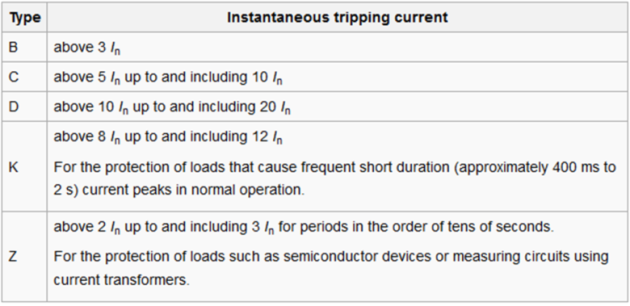Circuit breaker
A circuit breaker is an automatically operated electrical switch designed to protect an electrical circuit from damage caused by Overcurrent/overload or short circuit. Its basic function is to interrupt current flow after Protective relays detect faults condition. Unlike a fuse, which operates once and then must be replaced, a circuit breaker can be reset (either manually or automatically) to resume normal operation. Circuit breakers are made in varying sizes, from small devices that protect an individual household appliance up to large switchgear designed to protect high voltage circuits feeding an entire city. (Wikipedia)
As per the nature of the current, especially in case of short circuit, the circuit breaker has the ability to cut electric arc. For this, different methods are used:
Low-voltage MCB (Miniature Circuit Breaker) uses air alone to extinguish the arc. These circuit breakers contain so-called arc chutes, a stack of mutually insulated parallel metal plates which divide and cool the arc. By splitting the arc into smaller arcs the arc is cooled down while the arc voltage is increased and serves as additional impedance which limits the current through the circuit breaker.
The current-carrying parts near the contacts provide easy deflection of the arc into the arc chutes by a magnetic force of a current path, although magnetic blowout coils or permanent magnets could also deflect the arc into the arc chute (used on circuit breakers for higher ratings). The number of plates in the arc chute is dependent on the short-circuit rating and nominal voltage of the circuit breaker.
In larger ratings, oil circuit breakers rely upon vaporization of some of the oil to blast a jet of oil through the arc. Gas (usually sulphur hexafluoride) circuit breakers sometimes stretch the arc using a magnetic field, and then rely upon the dielectric strength of the sulphur hexafluoride (SF6) to quench the stretched arc. Vacuum circuit breakers have minimal arcing (as there is nothing to ionize other than the contact material), so the arc quenches when it is stretched a very small amount (less than 2–3 mm (0.079–0.118 in)). Vacuum circuit breakers are frequently used in modern medium-voltage switchgear to 38,000 volts. |  |
 | Air circuit breakers may use compressed air to blow out the arc, or alternatively, the contacts are rapidly swung into a small sealed chamber, the escaping of the displaced air thus blowing out the arc. Circuit breakers are usually able to terminate all current very quickly: typically the arc is extinguished between 30 ms and 150 ms after the mechanism has been tripped, depending upon age and construction of the device. The maximum current value and let-through energy determine the quality of the circuit breakers. (Wikipedia) |
Definition : Current Rating
Circuit breakers are manufactured in standard sizes. Miniature circuit breakers have a fixed trip setting. Larger circuit breakers can have adjustable trip settings
International Standard--- IEC 60898-1 and European Standard EN 60898-1 define the rated current In of a circuit breaker for low voltage distribution applications as the maximum current that the breaker is designed to carry continuously (at an ambient air temperature of 30 °C). The commonly-available preferred values for the rated current are 6 A, 10 A, 13 A, 16 A, 20 A, 25 A, 32 A, 40 A, 50 A, 63 A, 80 A, 100 A and 125 A (similar to the R10 Renard series, but using 6, 13, and 32 instead of 6.3, 12.5, and 31.5 – it includes the 13A current limit of British BS 1363 sockets). The circuit breaker is labelled with the rated current in amperes, but without the unit symbol "A". Instead, the ampere figure is preceded by a letter "B", "C" or "D", which indicates the instantaneous tripping current — that is, the minimum value of current that causes the circuit breaker to trip without intentional time delay (i.e., in less than 100 ms), expressed in terms of In:






